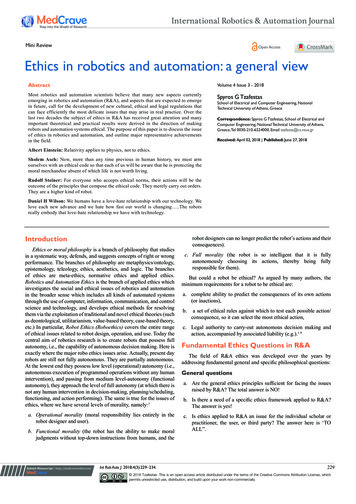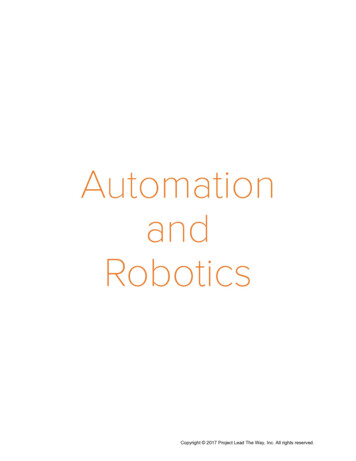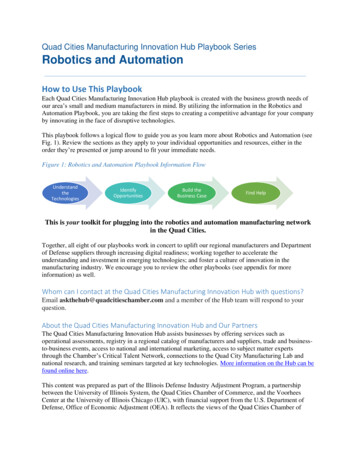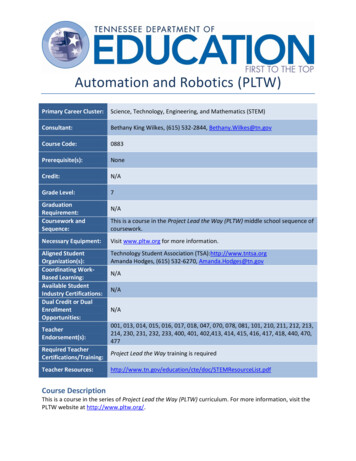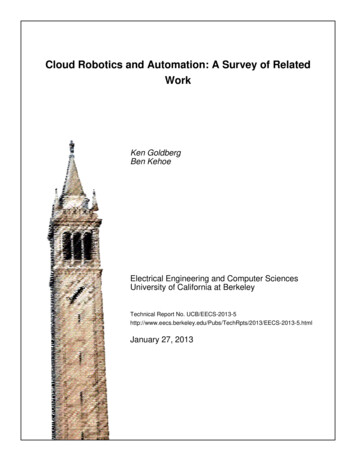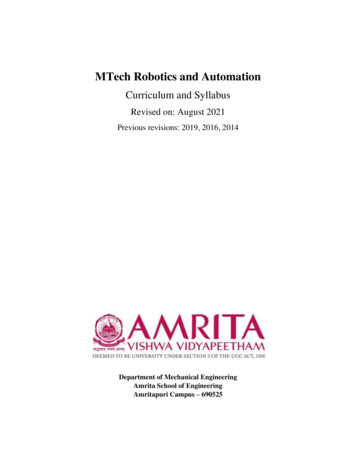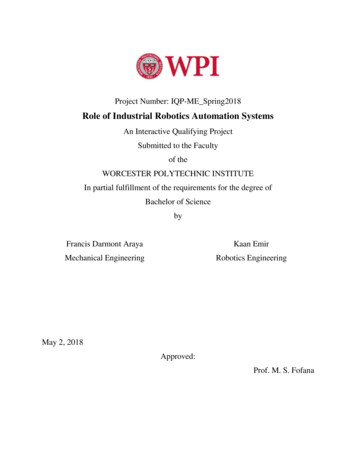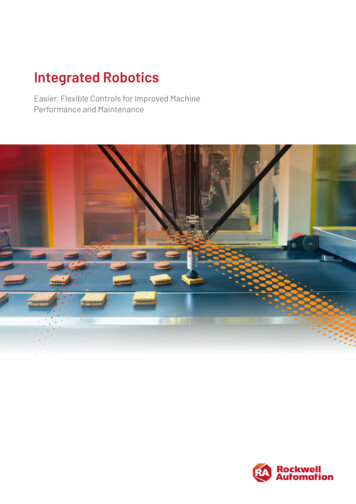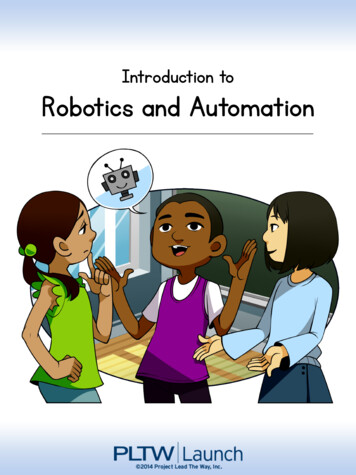
Transcription
Introduction toRobotics and Automation
Page 1 / 20Part 1When Mylo entered Ms. Morales’s classroom, he gotexcited as he noticed the questions written on the board:When you think of a robot, what comes to mind?Is the robotyou consideredmore like ahuman or amachine?Just what is a robot, anyway?“Robots!” Mylo thought. “That’s a topic I think I willenjoy.”
Page 2 / 20His mind raced as he tried to settle on just one robotto describe. He had collected and played with robotic toyssince he was four years old. From the first time he watchedthe movie Robots, Mylo was fascinated with robotics. Hecouldn’t wait for class to begin!Angelina’s response to seeing the questions on the boardabout robots was not quite as enthusiastic as that of herfriend Mylo.
Page 3 / 20As Angelina walked into the room in front of Suzi, sheturned around and said, “Robots? Who cares about robots?Aren’t they just toys and characters in movies or maybesomething people think will be real in the future? ”Suzi responded, “I bet Mylo is excited about this topic.He loves robots! Who knows? Maybe this will be fun. Maybewe will get to build a robot.”“Sure,” said Angelina. “I’m going to have to be convinced.”The girls took their seats just as Ms. Morales called theclass to order.Ms. Morales began by saying, “Today we are going tostart our quest toward a new design problem. Before wetalk about it as a class, I would like for you to respond tothe questions I have posted on the board with your group.Let’s see what kind of ideas we have about robotics.”
Page 4 / 20As she checked attendance, the student groups beganto share their responses to the questions — some moreenthusiastically than others!After about five minutes of group discussion, Ms.Morales brought the class back together to share ideas. Asthe class discussed their knowledge of robots and even somemisconceptions people have about robots, the excitementbegan to grow.“My dad operates a robot thatpaints cars as they go throughthe assembly line,” Sean shared.“They have the painting robot ina big booth so that paint does notget sprayed all over the factory.”Angelina asked, “Have you seenthis robot?”
Page 5 / 10“Yes,” replied Sean. “My dad took us on a tour. It is reallycool to watch the car being painted by robotic arms whilethe operator works outside the booth and stays completelyclean. In fact, many robots work on the cars as they gothrough the assembly line.”Suzi commented, “I always thought a robot had to lookmore like a human. I’d love to see what a robotic arm lookslike and how it works.”Another student describeda robotic vacuum cleanerthat moves around theroom using sensors toavoid furniture and walls.Mylo added, “I need oneof those at my house! Just think I could play video gameswhile the robot cleaned my room!”
Page 6 / 20As the students continued to share what they know aboutrobots, Ms. Morales asked the class to consider what theywanted to learn about robotics. At this point even Angelinawas starting to join in as students enthusiastically listedwhat they would like to learn.“We are going to use our iPad tablets to research robotics,” Ms.Morales announced as the discussionwas coming to an end.It didn’t take long for the studentsto dive into the Robots for iPad appthat Ms. Morales demonstrated. Infact, the time allotted for researchended far too quickly for the class.“Can’t we spend 15 more minuteson this research?” Angelina asked.
Page 7 / 20“I just found this amazing robot that can be used to cleanup hazardous wastes. I had no idea that robots were reallyuseful and not just something for the movies!”“Angelina, your comment leads us directly to our designproblem. You are going to work with a group to design, build,and evaluate a robot using our VEX IQ equipment thatcan remove hazardous waste from an area. An exampleof using robots to clean up after a natural disaster comesfrom the aftermath of a 2011earthquake and tsunami in Japan.Dealing with hazardous materialsfrom the Fukushima Dai-ichi nuclearpower plant has been a critical partof the cleanup process. From thisdisaster, we find a great exampleof how robots can be used to dowork that is far too dangerous forhumans.”
Page 8 / 20Ms. Morales shared the following information about theuse of robots in cleaning up this disaster:On March 11, 2011, Japan faced disaster from a major 9.0magnitude earthquake and a resulting tsunami. One ofthe dangerous results of this natural disaster was thedevastation to the Fukushima Dai-chi nuclear power plant.While the nuclear reactors did not suffer major damagefrom the earthquake, the tsunami that followed provedto be disastrous. The tsunami covered the pumps with seawater. In addition to needing to cool the reactors, radiationwas being discharged into the environment through theatmosphere and through discharges of contaminated waterfrom the plant to the ocean.
Page 9 / 20Due to the dangerous radiation levels within the plant, humanswere unable to safely enter. Thus, robots played a partof the emergency response to this problem. Three of therobots included the 710 Warrior and the Packbot developedby iRobot as well as the Quince 2 developed by Japan’s ChibaInstitute of Technology.The 710 Warrior, “a rugged,gear-footed prototype,” wentinto the Fukushima Dai-chiplant to explore the damagednuclear reactors and also collectradioactive dust (Koren, 2013).The 710 Warrior can performmuch like a “firefighter” as itcan carry hoses, climb stairs,work underwater, and maneuverover obstacles. This robot canalso carry up to 200 pounds.Live video data collected through the camera sensor can betransmitted back to the controller over a wireless range ofabout 200 feet.
Page 10 / 20While the Packbot has been used to diffuse bombsin military pursuits, its use at Fukushima was primarilysurveillance and reconnaissance using its sensors to detecttemperature, radiation, toxic chemicals, and environmentaloxygen levels. The Packbot can then transmit the data to thecontrollers in real-time. The Packbot and the 710 Warriorrobots were the first robots to enter the disaster site atFukushima.Another robot used in addressing this disaster is theQuince 2, which can be remotely controlled from distances asfar as 1.5 miles away from the site. The first version of thisJapanese robot actually got stuck within the nuclear plant.An upgraded robot was developed that includes cameras,hygrometers, and thermometers among its sensors. Thisrobot was used to monitor levels of radiation and collectsamples from the reactor.After discussing the use of robots at the FukushimaDai-chi nuclear plant, Ms. Morales introduced the roboticdesign problem for the class.
Page 11 / 20“You will work with a group to design a robot that canremove dangerous waste from a disaster site,” Ms. Morales began.As soon as she handed out the design problem to thestudents, they began to consider the criteria and constraints they would need to follow.
Page 12 / 20Part 2As Mylo, Angelina, and Suzi walked to school the followingday, their conversation was all about robots.“I hope we get time to use the Robots for iPad app againtoday,” Mylo commented.
Page 13 / 20Suzi responded, “I had no idea that learning about robotscould be so cool. Did you see the Da-Vinci surgical robot?Can you believe that a surgeon can control the roboticarms to actually perform heart surgery?”Angelina joined in, “That was amazing! Before yesterday,I thought of robots as being characters in science fictionmovies or something for thefuture. My group researchedindustrial robots and I had noidea robots were used so muchin manufacturing plants.”“I’ve played around withrobots for years,” Myloadded. “After yesterday, Iam beginning to think that thismight be something I wouldlike to do for a job.”
Page 14 / 20The three friends continued to talk about robots all theway to school and whenever they had a chance throughoutthe day. They could hardly wait for Ms. Morales’s class tostart that afternoon.At lunch they started talking about the design problemof building a robot that could remove hazardous materialsfrom a site.Suzi remarked, “Maybe we will get towork on our design today. It’s going tobe really cool building a robot that doessomething!”Angelina added, “I think we couldcreate a .”Mylo interrupted her, “I amexcited about this also, but we have to
Page 15 / 20remember the Design Process. Before we are ready tocreate a robot, we have some work to do.”“I know,” Angelina continued, “We need to make surewe really understand the problem first. Making sure ourrobot solves the problem using the criteria and constraintsMs. Morales gave us will be important.”Suzi chimed in, “Then there is the Explore part of thedesign process. We did some research, but we probablyneed to learn more about robots that have already beenbuilt to do this.”“We really don’t know a lot about building robots yeteither. Working with the VEX IQ kits will be awesome! Maybewe will start learning how to use them today.”
Page 16 / 20Part 3Now that the class had researched the field of robotics,learned about inputs and outputs, and actually built a roboticchassis, they were anxious to tackle the design problem.They were ready to put their knowledge and skills to use insolving a real-world problem.Ms. Morales started class by saying, “Today you will useyour previous work to help you develop ideas for designinga robot that can be used to remove hazardous wastesfrom a site. Let’s review to make sure we understand theproblem and the criteria and constraints you have beengiven.”Mylo raised his hand first. He stated, “Our robot mustkeep the basic chassis design that we built earlier. It isokay to add parts, but we can’t remove any of the basicchassis parts.”
Page 17 / 20The students discussed the need to be able to use thecontroller to remotely control the robot as it moves throughthe site.“What criteria do you need to use for creating yoursite?” Ms. Morales asked.
Page 18 / 20“The size of the site we create must not be greaterthan 5 feet by 5 feet,” Suzi replied. We also need to havea hazardous materials collection zone.”“We need to have a water feature on our site,”Angelina added. “We can use butcher paper, poster board,construction paper, or masking tape to create our site.”
Page 19 / 20The teacher asked the students to recall what they willuse to represent the hazardous materials and the minimumnumber that must be moved in order to be successful. Aftertheir questions had been addressed, she asked the group“So, what is the next step as you work through thisdesign process?”“We need to come upwith several good ideason our own so that thegroup will be able toselect the best designfor solving the problem,”Mylo responded.The time had cometo dive into solving thedesign problem by creating a robotic prototype. After
Page 20 / 20asking and exploring the problem, the students were morethan ready to put their ideas on paper and move one stepcloser to building their design.
Robotics and Automation. Page 1 / 20 Part 1 When Mylo entered Ms. Morales’s classroom, he got excited as he noticed the questions written on the board: . Now that the class had researched the field of robotics, learned about inputs and outputs, and actually built a robotic cha


